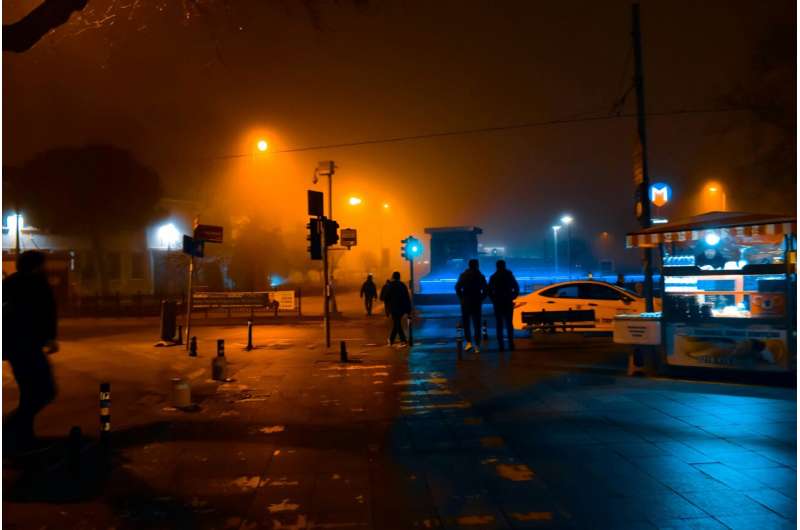This article has been reviewed according to Science X's editorial process and policies. Editors have highlighted the following attributes while ensuring the content's credibility:
fact-checked
peer-reviewed publication
trusted source
proofread
Streetlights running all night makes leaves so tough that insects can't eat them, threatening the food chain

Light pollution disrupts circadian rhythms and ecosystems worldwide—but for plants, dependent on light for photosynthesis, its effects could be profound. Now scientists writing in Frontiers in Plant Science have found that exposure to high levels of artificial light at night makes tree leaves grow tougher and harder for insects to eat, threatening urban food chains.
"We noticed that, compared to natural ecosystems, tree leaves in most urban ecosystems generally show little sign of insect damage. We were curious as to why," said corresponding author Dr. Shuang Zhang of the Chinese Academy of Sciences. "Here we show that in two of the most common tree species in Beijing, artificial light at night led to increased leaf toughness and decreased levels of leaf herbivory."
Shedding some light
Artificial light has increased levels of night-time brightness by almost 10%: most of the world's population experiences light pollution every night. Because plant properties affect their interactions with other plants and animals, any changes to plants caused by artificial light could have a significant impact on the ecosystem.
"Leaves that are free of insect damage may bring comfort to people, but not insects," said Zhang. "Herbivory is a natural ecological process that maintains the biodiversity of insects."
The scientists suspected that plants experiencing high levels of artificial light would focus on defense rather than growth, producing tougher leaves with more chemical defense compounds. To test this, they selected two common species of street tree: Japanese pagoda and green ash trees. Although these trees are similar in many ways, Japanese pagoda trees have smaller, softer leaves which herbivores prefer.
The scientists identified 30 sampling sites spaced by roughly 100 meters on main roads which are usually illuminated all night. To determine the level of exposure to artificial lighting, they measured illuminance at each site. Almost 5,500 leaves were collected and evaluated for insect herbivory and traits that could be affected by artificial light, like size, toughness, water content, and levels of nutrients and chemical defenses.
Larger leaves would indicate resources allocated to growth, while toughness and higher levels of chemical defenses like tannins would indicate resources allocated to defense. Meanwhile, higher levels of water and nutrients indicate higher-quality nutrition to tempt herbivores.
Hard to swallow
For both species of tree, higher levels of artificial light meant tougher leaves. The tougher the leaf, the less evidence of insect herbivory. The more intense the light, the more frequently scientists encountered leaves that showed no signs at all of herbivory.
"The underlying mechanism for this pattern is not yet fully understood," said Zhang. "It is possible that trees exposed to artificial light at night may extend their photosynthesis duration. Additionally, these leaves might allocate a greater proportion of resources to structural compounds, such as fibers, which could lead to an increase in leaf toughness."
Japanese pagoda trees exposed to more artificial light had lower levels of nutrients like phosphorus: where Japanese pagoda leaves had more nutrients, more herbivory occurred. But green ash leaves were more strongly influenced by higher light levels: they had higher levels of nitrogen, smaller leaves, and lower chemical defenses.
This could be because green ash trees are less preferred by herbivores, so they can afford to allocate resources to growth. Meanwhile, Japanese pagoda trees put more resources into defense, lowering their nutrient content.
Insects going hungry
"Decreased herbivory can lead to trophic cascading effects in ecology," said Zhang. "Lower levels of herbivory imply lower abundances of herbivorous insects, which could in turn result in lower abundances of predatory insects, insect-eating birds, and so on. The decline of insects is a global pattern observed over recent decades. We should pay more attention to this trend."
Although leaf toughness is a mechanical defense against predation, it is possible that other factors contribute to decreased herbivory: for instance, more light could make insects more visible to their predators. Further research will be needed to fully understand the effects of artificial light.
"Our study was conducted in only one city and involved just two tree species," cautioned Zhang.
"This limitation hinders our ability to generalize the conclusions to broader spatial and taxonomic scales. Research on how urbanization affects insects and insect-related ecological processes is still in its infancy."
More information: Artificial light at night decreases leaf herbivory in typical urban areas, Frontiers in Plant Science (2024). DOI: 10.3389/fpls.2024.1392262
Journal information: Frontiers in Plant Science
Provided by Frontiers





















